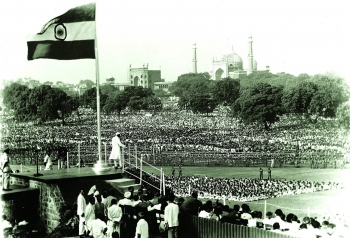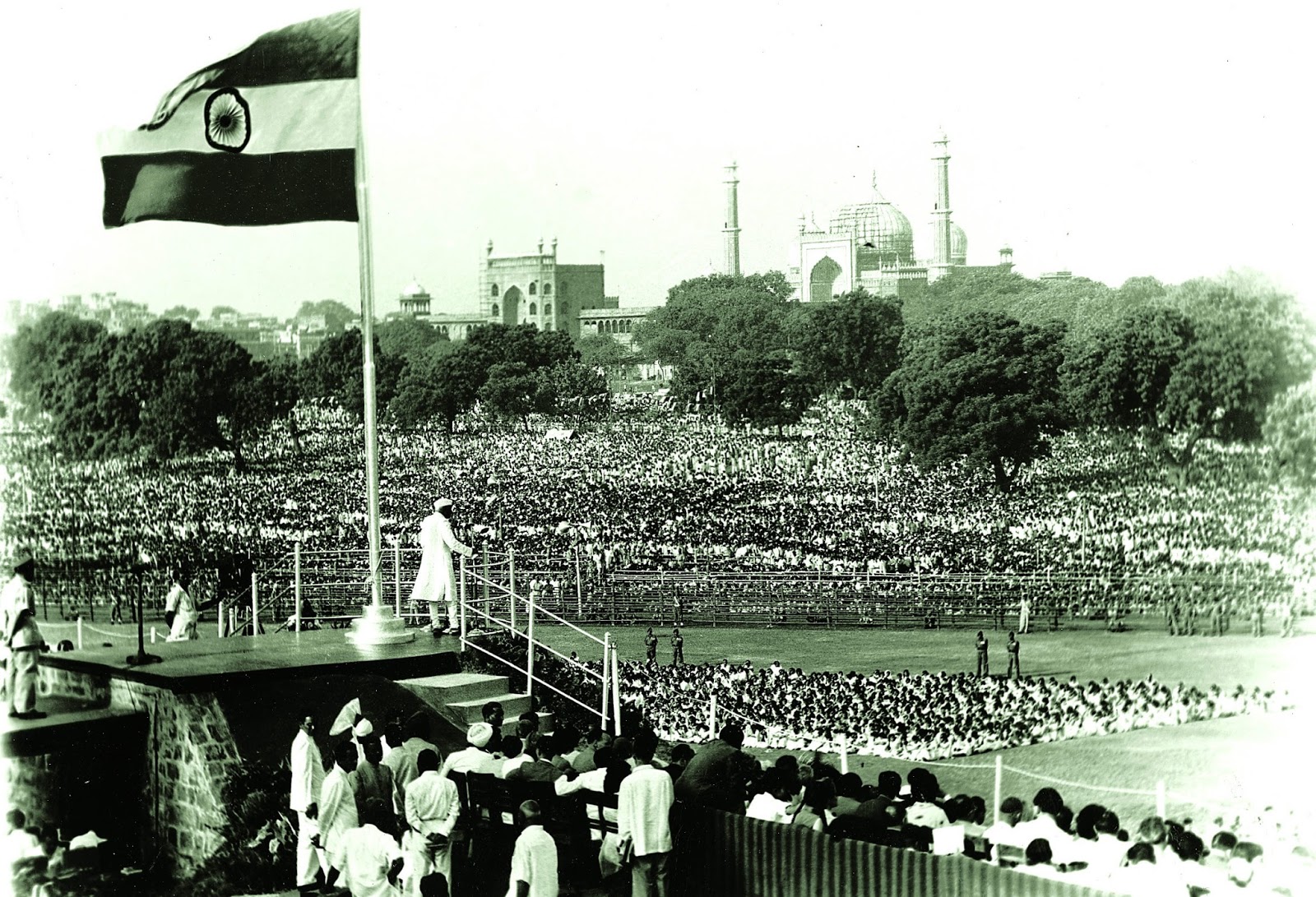
.png) John Dayal
John Dayal

I am not a Midnight Child. My mother was in no hurry. I was born several months later. But I am still older than the Republic of India, even if I missed its birth as an independent nation, bloodied in the severance with its brother, Pakistan, and crying for those tens of millions of Hindus, Muslims, Sikhs, and some Christians too, who were killed, raped, looted, and forced to flee their homes.
Prime Minister Narendra Modi wants us to hail the 75th year of Independence no less but as the “Nectar of Immortality Grand Festival”, the Amrit Mahotsav.
He also wants us to simultaneously observe the day with a “Horrors of Independence” memory. He wants the Hindus and the Sikhs, who fled their homes in West Punjab, the Frontier provinces, Baluchistan and Sindh, to remember the murder of their parents and grandparents, the rape of their aunts and sisters, and even mothers, as they left their homes and villages to race to the Independent India. Many fell to sword, knife, and gun long before they reached the border. Many women lived, but never made it to the border.
But Mr. Modi’s media and social media army tell us in so much unsaid shouts that no Muslim was killed, that the Muslim was the killer, the abductor, the rapist.
I’ve seen no reports in the national and international media if Pakistan, whose people celebrate Independence a day earlier, on 14th of August, is also observing a “Horrors of Partition Day”. They would have every right to do so if their government or ruling party so chose. And if we did not give them ideas.
India and Pakistan have enough visual, audio, and documented material on the horrors. Much of Pakistan is bereft of Hindus and Sikhs who were born there. The bodies would have been cremated on mass pyres or buried in pits and old wells. Many of the women left behind, or “captured’, possibly married their captors, and had children.
It happened here, in India, too in what are today Punjab, Haryana, Jammu, parts of Rajasthan, Delhi, Uttar Pradesh, Bihar, Madhya Pradesh and even beyond the Narmada, and in the East, in the sliced Bengal, and areas of what is now Assam.
Partition has impacted politics in both India and Pakistan for 75 years, much more than 200 years of colonial rule. The Deccan was spared to an extent, and the lands of the Tamils, the Kannadigas, the Konkans and the Malayalees.
The difference was that even after partition, a very large number of Muslims chose to remain in India, by choice or by default. In Pakistan only a handful of Sikhs and Hindus remained. A few of them have crossed to India in the last few decades.
Mr. Modi’s arousing passions in India, seventy-five years later, has little to do with sympathy for the wounded. It has to do with his preparation for a third term in the battle of general elections of 2024, for which his party has again chosen him as the commander-in-chief.
He wants no hitch, no pothole, no barrier and certainly no person or party to come in his way.
Mr. Modi can use the Partition, and bend history his way, because there really has been no counting of the dead, no allowing the ghosts to find peace, and no balm to those whose kin is still missing.
Neither India nor Pakistan has issued White Paper on the human toll of Partition across the line drawn by the colonial British, whose officers were still controlling large numbers of police and military in both countries under the nominal control of the governments of two independent nations.
With several wars, a constant threat of subversion and terrorism and a nuclear bomb-powered military stand-off between the two countries, there is no question of any talk of a Truth and Reconciliation Commission to heal wounds and give the two nations and their new generations of citizens a clean slate to write their future. Only a handful of human rights activists in the two countries dare to dream of a future with peace.
It would be difficult to guess a body count now. But many Hindus live in properties in India once owned by Muslims, as much as Muslims in Pakistan live in houses of Hindus which were allotted to them or captured by them during or after the partition violence. These properties are now known as Enemy Property, under laws in the two countries.
Periodically, social media and television stories abound of siblings re-uniting now in their nineties – a brother Hindu and a sister Muslim, or vice versa, depending on how they were separated from their families. The rich nawabs and Rajput Muslims of Pakistan still cross the border to take brides from families of their rank for their grandsons.
Prime Minister Jawaharlal Nehru could have been overwhelmed by the refugees wading through rivers of blood. It goes to him and his colleagues that almost every Hindu and Sikh was given house or land and compensation. The national capital itself changed not just in its historical character but demography too.
I know these first-hand. As newly-weds, my wife and I lived among the refugees from West Punjab and later in a colony where those from East Bengal were settled; we lived half a decade among them. We listened to their stories of sheer horrors of Pakistan, their struggle in the refugee camps, and how, with just a little money, they had rehabilitated themselves. I met people, who had begun living in tents, and running small shops on pavements, who had risen to be industrialists, police officers, politicians, and even Member of Parliament. I also knew a real gangster of the stature of a local godfather.
The stories of resilience of these people, including that of the gangster, gave all of us hope that left to themselves and with a nurturing environment, these victims of Partition could heal themselves, and regain their strength and dignity.
The people, responding to Modi’s dog whistle, surely are a new generation, a third or fourth generation of people who are rootless not because of Partition but because of unemployment, inequity, and increasing gap between the super-rich and the average and poor citizens. Mr. Modi has not bridged the gap. His policies, and his open favours given through official channels to a handful, help a cartel of industrialists of his choice.
How will these groups, marching to the drum beat of private armies of the likes of the Chief Minister of Uttar Pradesh and the traditional but now hugely inflated ranks of the Rashtriya Swayamsevak Sangh, pave the way for a third-term Modi. And will that Modi be benign now that his mark on India’s history has been deeply carved, or will he speak of a thousand-year Reich?
We all know how thousand-year Reich ended. Therefore, what about the final quarter of the independent nation’s centenary?
No midnight child I am, but as a grandfather of a 14-year-old boy of a mixed Telugu-Syrian-Bengali heritage (with a dash of East Bengali genes), I ask this question: What is the India my grandson, then a man in his late thirties, will see?
The first quarter of new India’s century was one of courage, soothing balm, healing, and hope. Despite the shock of two wars, in 1948 stand-off with the nascent Pakistan, and a humiliation at the hands of China in 1962, Nehru laid the foundations of education and technology that in time have seen a Punjabi Indian scientist, Har Govind Khurana, win a Nobel prize. And an entire army of technocrats from India’s flowering Institutes of Technology, science, and medicine, would join the post-World War II leap of science and technology in the United States of America. India is well set to send a man to the moon, a mission to Mars, and may even discover a new molecule which will enable Indian and global pharma to make cheaper life-saving drugs. As Pakistan and the neighbours seem to disintegrate into military doctorships and fundamentalist politics, India consolidated its democracy.
The second quarter of the century consolidated democracy further. But it was first marred by the State of Emergency imposed by Prime Minister Indira Gandhi after she lost a democratic election. Her defeat was propelled by a popular movement that morphed into a rebellion against her. She lost the general elections after Emergency; but won the next as those who defeated her could not continue together.
Her return to power in a couple of years was marred by the rise of aberrant political forces such as the Khalistan movement which eventually led to the military action in the Golden Temple, holy to the Sikhs, and the consequent assassination of Indira Gandhi by her Sikh guards. Possibly more than 5,000 Sikhs were stabbed or burnt to death in the national capital and several towns of the north. A regiment of the Indian army mutinied.
The third quarter of the century has seen the rise of Hindutva. It began with the decision of the Bharatiya Janata Party, which was rebuilt on the Jana Sangh of the pre-Emergency period, that it could become a political challenge not on a popular or economic platform, but one designed to gather the Hindu masses in a matrix of militant faith. The existence of the Muslims in free India despite partition, and the slogan to rebuild a Hindu Rashtra were to be the fuel and the goal.
Mr. Modi can be said to be the best product of the slogan first raised by Mr. Lal Kishan Advani, a refugee from Sindh, as he began his march in the 1990s to rebuild Ram Temple after razing the Babri Masjid in Ayodhya. The 500-year-old mosque was razed by Sangh armies as the police, the Army and the Supreme Court watched, and the Congressman Prime Minister, Mr. P.V. Narasimha Rao, had a long siesta.
The period saw Mr Rao privatize the economy and dilute the socialism Nehru and Indira had brought in. The World Bank and the International Monetary Fund were happy, as was India Incorporated. After an intervening seven years of BJP leader Atal Behari Vajpayee’s rule, considered benign in retrospect, Congressman Manmohan Singh completed the task he had begun as Mr Rao's Finance Minister.
Mr Modi won the general elections of 2014 fair and square, if you can see fairness and lawfulness in a campaign built on a rhetoric of elimination of a group of citizens of their citizenship and possibly life itself.
Mr Modi is not unfamiliar with bloodshed as a consequence of hate. He presided over the massacre of Muslims in Gujarat in 2002.
Patently he is not threatened by, or afraid of, any national or international opposition to these policies. He thinks the cadres he and his Home Minister Amit Shah have trained will overcome any resistance that may come during the 2024 general elections or the ones after that.
Is he correct in his thinking, or will the nation, and its people, ensure that the years towards the Century, in 2047, will again be of rebuilding, and encouragement to reason, science and a commitment to the welfare of all people.
I would like to hope that Nehru’s dream, and the dream of those of us now as old as Independent India, will not shatter.